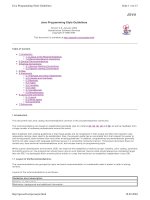Java programming JavaNetwork i
Bạn đang xem bản rút gọn của tài liệu. Xem và tải ngay bản đầy đủ của tài liệu tại đây (152.53 KB, 15 trang )
Java Programming II
Java Network (I)
Java Programming II
1
Contents
Internet
Addresses
Server Sockets and Sockets
Datagram Sockets and Packets
Uniform Resource Locators (URL)
Java Programming II
2
OSI 7 Layers
End host
End host
Application
Application
Presentatio
n
Presentatio
n
Session
Session
Transport
One or more nodes within the
network
Transport
Network
Network
Network
Network
Data Link
Data Link
Data Link
Data Link
Physical
Physical
Physical
Physical
Java Programming II
3
Internet Structure
FTP
HTTP
NV
TFTP
TCP
UDP
Application
IP
TCP
UDP
IP
NET1
NET2
NETn
Network
Other Structure of Internet
Internet Protocol Graph
Java Programming II
4
Internet Addresses
Transmission Control Protocol (TCP) :
To obtain reliable, sequenced data
exchange.
User Datagram Protocol (UDP) : To
obtain a more efficient, best-effort
delivery.
GetByName() Method
static InetAddress getByName (String hostName)
throws UnknownHostException
- Determines the IP address of a host, given
the host's name.
getAllByName() Method
static InetAddress[] getAllByName (String
hostName) throws UnknownHostException
- Given the name of a host, returns an
array of its IP addresses, based on the
configured name service on the system.
getAddress() Method
Byte[] InetAddress getLocalHost()
- Returns the raw IP address of this InetAddress
object.
import java.net.*;
class InetAddressDemo {
public static void main(String args[]) {
try {
InetAddress ias[] =
InetAddress.getAllByName(args[0]);
for (int i = 0; i < ias.length; i++) {
System.out.println(ias[i].getHostName());
System.out.println(ias[i].getHostAddress());
byte bytes[] = ias[i].getAddress();
for (int j = 0; j < bytes.length; j++) {
if (j > 0)
System.out.print(".");
if (bytes[j] >= 0)
System.out.print(bytes[j]);
else
System.out.print(bytes[j] + 256);
}
System.out.println("");
}
}
catch (Exception e) {
e.printStackTrace();
}
}
}
/>html
Java Programming II
5
Socket Call for Connection-Oriented
Protocol
Server
socket()
bind()
Client
listen()
socket()
accept(
)
connection establishment
Blocks until connection from client
read()
connect(
)
Data (request)
write()
Process request
Data (reply)
read()
write()
Java Programming II
6
Socket Call for Connectionless
Protocol
Server
socket()
Client
bind()
socket()
recvfrom()
Blocks until data recv. from client
bind()
Data (request)
Process request
Data (reply)
write()
Java Programming II
sendto(
)
recvfro
m()
7
Server Sockets and Sockets
Socket Class
ServerSocket Constructor
This class implements server sockets. A
server socket waits for requests to come in
over the network. It performs some operation
based on that request, and then possibly
returns a result to the requester.
ServerSocket(int port) throws IOException
- Creates a server socket, bound to the
specified port.
accept() Method
Socket accept() throws IOException
- Listens for a connection to be made
to this socket and accepts it.
bind() Method
Socket accept() throws IOException
- Binds the ServerSocket to a specific
address (IP address and port number).
close() Method
void close() throws IOException
- Closes this socket.
This class implements client sockets (also
called just "sockets"). A socket is an
endpoint for communication between two
machines.
Socket(String hostName, int port) throws
UnknownHostException, IOException
- Creates a stream socket and connects it to
the specified port number at the specified IP
address.
getInputStream(),
getOutputStream Method
InputStream getInputStream() throws
IOException
-Returns an input stream for this socket.
OutputStream getOutputStream() throws
IOException
- Returns an output stream for this socket.
close()
void close() throws IOException
- Closes this socket.
/>.html
/>
Java Programming II
8
Server Sockets and
Sockets
import java.io.*;
import java.net.*;
import java.util.*;
class SocketDemo {
public static void main(String args[]) {
try {
//Get Server and Port
String server = args[0];
int port = Integer.parseInt(args[1]);
//Create socket
Socket s = new Socket(server, port);
//Read random number from server
InputStream is = s.getInputStream();
DataInputStream dis = new
DataInputStream(is);
int i = dis.readInt();
//Display Result
System.out.println(i);
//Close Socket
s.close();
}
catch (Exception e) {
System.out.println("Exception: " + e); }
}
}
class ServerSocketDemo {
public static void main(String args[]) {
try {
// Get Port
int port = Integer.parseInt(args[0]);
Random random = new Random();
//Create Server Socket
ServerSocket ss = new
ServerSocket(port);
//Create Infinite Loop
while(true) {
//Accept Incoming Requests
Socket s = ss.accept();
//Write Result to Client
OutputStream os =
s.getOutputStream();
DataOutputStream dos = new
DataOutputStream(os);
dos.writeInt(random.nextInt());
Running :
//Close socket
s.close();
}
}
}
}
catch (Exception e) {
System.out.println("Exception: " + e);
% java ServerSocketDemo 4321
% java SocketDemo 127.0.0.1 4321
}
Java Programming II
9
Datagram Sockets and
Packets
UDP does not guarantee reliable, sequenced data
exchange, and therefore requires much less overhead .
DatagramPacket Constructor
DatagramPacket(byte buffer[], int size)
send() Method
void send(DatagramPacket dp) throws
IOException
DatagramPacket(byte buffer[], int size,
InetAddress ia, int port)
close() Method
DatagramSocket() Method
DatagramSocket() throws SocketException
DatagramSocket(int port) throws
SocketException
void close()
receive() Method
void receive(DatagramPacket dp) throws
IOException
/>t.html
Java Programming II
10
Datagram Sockets and Packets
class DatagramReceiver {
private final static int BUFSIZE = 20;
public static void main(String args[]) {
try {
//Obtain port
int port = Integer.parseInt(args[0]);
//Create a DatagramSocket object for the
port
DatagramSocket ds = new
DatagramSocket(port);
//Create a buffer to hold incoming data
byte buffer[] = new byte[BUFSIZE];
class DatagramSender {
public static void main(String args[]) {
try {
// Create destination Internet address
InetAddress ia =
InetAddress.getByName(args[0]);
// Obtain destination port
int port = Integer.parseInt(args[1]);
// Create a datagram socket
DatagramSocket ds = new
DatagramSocket();
//Create a datagram packet
byte buffer[] = args[2].getBytes();
DatagramPacket dp =
new DatagramPacket(buffer, buffer.length,
ia, port);
// Send the datagram packet
ds.send(dp);
//Create infinite loop
while(true) {
//Create a datagram packet
DatagramPacket dp =
new DatagramPacket(buffer,
buffer.length);
//Receive data
ds.receive(dp);
//Get data from the datagram packet
String str = new String(dp.getData());
// Display the data
System.out.println(str);
}
}
}
}
catch (Exception e) {
e.printStackTrace();
}
}
}
}
catch (Exception e) {
e.printStackTrace();
}
Running :
% java DatagramReceiver 4321
% java DatagramSender localhost 4321 Message
Java Programming II
11
Uniform Resource Locators
(URL)
openStream() Method
URL
InputStream() throws IOException
Protocol://host:/port/file
URL Constructor
URL(String protocol, String host, int port, String
file)
throws MalformedURLException
getFile(), getHost(),
getPort(), and getProtocol()
Methods
String getFile()
URL(String protocol, String host, String file)
throws
MalformedURLException
String getHost()
URL(String urlString) throws
MalformedURLException
String getProtocol()
int getPort()
Refer to
/>
Java Programming II
12
URL Demo Example
class URLDemo {
public static void main(String args[]) {
try {
// Obtain URL
URL url = new URL(args[0]);
Run :
java URLDemo
// Obtain input stream
InputStream is = url.openStream();
// Read and display data from URL
byte buffer[] = new byte[1024];
int i;
while((i = is.read(buffer)) != -1) {
System.out.write(buffer, 0, i);
}
}
catch (Exception e) {
e.printStackTrace();
}
}
}
Java Programming II
13
Client and Server Application
import java.io.*;
import java.net.*;
public class Server
{
public ServerSocket svrSocket = null;
public Socket socket = null;
public InputStream inputStream = null;
public OutputStream outputStream = null;
public DataInputStream dataStream = null;
public PrintStream printStream = null;
public DataOutputStream dataoutputStream =
null;
public String message;
public BufferedReader charStream = new
BufferedReader(new
InputStreamReader(System.in));
public void readSocket(){
try {
message = dataStream.readUTF();
System.out.println(message + "\n");
if(message.equals("Exit")){
System.exit(0);
}
}
catch( UnknownHostException e) {
System.out.println("Error : Cannot find
server." + e);
}
catch( IOException e ) {
System.out.println("Error : I/O Error." + e);
}
}
public Server() {
try {
svrSocket = new ServerSocket(1056);
System.out.println("\nInitializint Port...");
System.out.println("\nListen...");
socket = svrSocket.accept();
System.out.println("\nConnect to Client!\n");
inputStream = socket.getInputStream();
dataStream = new
DataInputStream(inputStream);
outputStream = socket.getOutputStream();
dataoutputStream = new
DataOutputStream(outputStream);
public void writeSocket(){
try {
String initmsg_r = new String("Enter your
message: ");
dataoutputStream.writeUTF(initmsg_r);
System.out.print("Enter please for ready... ");
message = charStream.readLine();
if (! Message.equals(“Exit”)) return;
else {dataoutputStream.writeUTF(“Exit”);
System.exit(0); }
}
catch( UnknownHostException e) {
System.out.println("Error : Cannot find
message = dataStream.readUTF();
System.out.println(message + "\n");
server." + e);
} catch( UnknownHostException e) {
}
System.out.println("Error : Cannot find
catch( IOException e ) {
server." + e);
System.out.println("Error : I/O Error." + e);
}
}
catch( IOException e ) {
Java Programming
II
}
14
Client and Server Application
public static void main(String args[]) {
Server svr = new Server();
for(;;){
svr.writeSocket();
svr.readSocket();
}
}
dataStream = new DataInputStream(inputStream);
outputStream = socket.getOutputStream();
dataoutputStream = new
DataOutputStream(outputStream);
dataoutputStream.writeUTF(message);
} catch(UnknownHostException e) {
System.out.println("Error : Cannot find server." +
e);
}
catch(IOException e) {
System.out.println("Error : I/O Error." + e);
}
}
// End of Server
import java.net.*;
import java.io.*;
public class Client {
public static void main(String args[]) {
// Initialize the stream
OutputStream outputStream = null;
DataOutputStream dataoutputStream = null;
InputStream inputStream = null;
DataInputStream dataStream = null;
BufferedReader charStream = null;
// Initialize Socket
Socket socket = null;
String message;
try {
charStream = new BufferedReader(new
InputStreamReader(System.in));
message = new String("Hi! I am a client");
socket = new Socket("127.0.0.1", 1056);
while(true) {
try {
inputStream = socket.getInputStream();
dataStream = new
DataInputStream(inputStream);
message = dataStream.readUTF();
System.out.print(message);
if(message.equals("Exit")){ System.exit(0); }
message = charStream.readLine();
dataoutputStream.writeUTF(message);
} catch(UnknownHostException e) {
System.out.println("Error : Cannot find server." +
e);
}
catch(IOException e) {
System.out.println("Error : I/O Error." + e);
}
} // end of while
} // end of main method
} // end of Client Constructor
15
Java Programming II









